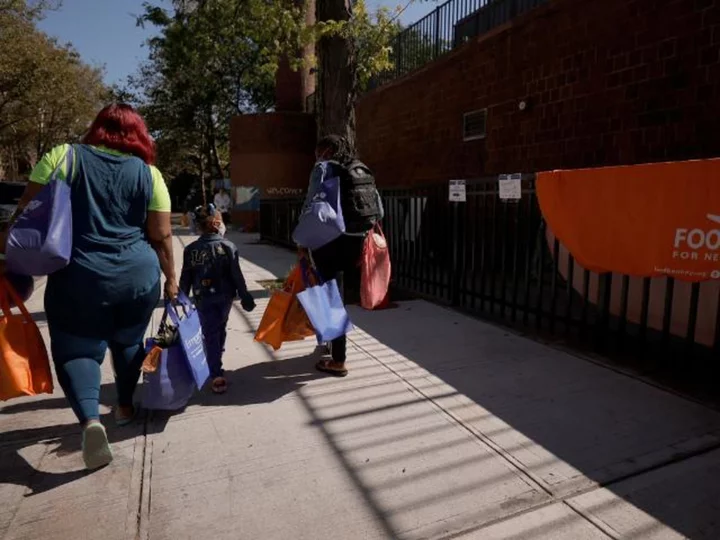The share of Americans, particularly children, in poverty rose significantly last year, in large part because Congress did not renew a Covid-19 pandemic enhancement to the child tax credit, according to Census Bureau data released Tuesday.
Some 12.4% of children were in poverty last year, up from a record low of 5.2% the year before and roughly comparable to where it was prior to the pandemic in 2019, based on a broader alternative measure developed by the Census Bureau. It was the largest jump in child poverty since the Supplemental Poverty Measure began in 2009. The measure takes into account certain non-cash government assistance, tax credits and needed expenses -- addressing a major flaw in the official poverty rate, economists say.
Overall, the supplemental poverty rate was 12.4% for 2022, up from 7.8% a year earlier and higher than it was prior to the pandemic. It's the first increase in the rate since 2010.
The official poverty rate of 11.5% was not statistically different than the prior two years.
Meanwhile, median household income was $74,580 last year, down 2.3% from 2021 and 4.7% lower than it was prior to the pandemic. The figures are adjusted for inflation.
And the uninsured rate fell to 7.9% last year from 8.3% in 2021 and comparable to where it was in 2017. However, the recent advance is not expected to continue in 2023 since states have restarted terminating the Medicaid coverage of residents they deem ineligible.
Child poverty rate more than doubles
The child poverty rate plummeted in 2021, thanks largely to a major, but temporary, boost to the child tax credit in the $1.9 trillion American Rescue Plan Act. It beefed up payments to $3,600 for each child up to age 6 and $3,000 for each one ages 6 through 17, for lower- and middle-income families for 2021. For the first time, half the credit was paid in monthly installments from July through December that year, while parents could claim the other half when they filed their 2021 taxes.
Plus, as part of the credit's enhancement, more low-income parents became eligible for the full amount because lawmakers made it fully refundable.
That boost lifted 2.1 million children above the poverty line in 2021, according to the Census Bureau. Other studies also found that the additional funds had a significant impact on reducing hardship among families with kids.
But since Congress did not extend the beefed up credit beyond 2021, the gain was short-lived. Other temporary pandemic relief programs, including a third round of stimulus payments in 2021, also contributed to the decline in poverty that year.
"Ensuring that children have their basic needs met is the bare minimum of what we can and should do," said Renee Ryberg, senior research scientist at Child Trends, a research organization. "The payoff for the health and wellbeing of our nation's children and for our society as a whole is immeasurable."
A group of Democratic lawmakers have been trying to revive the enhanced credit and unsuccessfully sought last year to tie it into a Republican wish-list item of extending certain corporate tax breaks. Colorado Sen. Michael Bennet, Ohio Sen. Sherrod Brown, Connecticut Rep. Rosa DeLauro, Washington Rep. Suzan DelBene and New York Rep. Ritchie Torres this year have introduced legislation to boost the child tax credit.
President Joe Biden also weighed in Tuesday, urging Congress to restore the enhancement.
Median income and earnings decline
Although the job market and economy were strong in 2022, both median household income and median earnings for workers declined, the latter sliding 2.2% last year.
That's partly because inflation outpaced the gains in earnings and partly because more people in the lower half of the pay scale entered the workforce, according to Liana Fox, assistant division chief in the bureau's social economic and housing statistics division.
Both figures were adjusted for an inflation rate of 7.8%, the largest annual increase in the cost of living adjustment used by the Census Bureau since 1981. The agency started using the Chained Consumer Price Index in this report.
Even a seemingly bright note in the report is not so rosy. Income inequality fell for the first time since 2007 -- but it was because of income among those in the middle and top brackets declined last year. The income of those at the bottom of the ladder did not change significantly from the prior year.
For the poorest one-fifith of households, the rise in prices was offset by strong job gains, and their wages kept up better with inflation, so that their median income did not decline, said Arloc Sherman, vice president for data analysis and research at the Center on Budget and Policy Priorities, an advocacy group.
The income and earnings declines will be another factor with which Biden has to contend as he tries to highlight his economic achievements -- dubbing it "Bidenomics" -- while gearing up for the 2024 presidential campaign.
Americans have a dour view of the economy in part because of the toll high inflation has taken on people's finances, though the pace of price increases has slowed.
Some 51% of the public say they think the economy is still in a downturn and getting worse, according to a CNN poll released last month.
What's more, only 24% of US adults said Biden's policies have improved economic conditions, according to another CNN poll released last week, while 58% said his policies have worsened economic conditions.
Health insurance gains won't last
The uninsured rate fell once again last year. Just under 26 million Americans lacked health insurance at any point last year, compared to just over 27 million people in 2021.
More working-age adults were covered by employer-based plans last year, contributing to a drop in their uninsured rate, the Census Bureau said.
Advocates, however, are concerned that many more people will become uninsured this year as states winnow their Medicaid enrollment for the first time since the pandemic began.
The number of Americans covered by Medicaid and the Children's Health Insurance Program had skyrocketed to 92.3 million by last December, up nearly 31% from February 2020, just before Congress prevented states from disenrolling ineligible residents in exchange for increased federal Medicaid funds, according to the Centers for Medicare and Medicaid Services.
But that protection ended in April. Since then, nearly 6 million people -- including at least 1.2 million children -- have lost their Medicaid coverage, according to KFF, formerly the Kaiser Family Foundation. A total of at least 15 million Americans might be disenrolled by the time the unwinding process ends next spring, according to various estimates.
The number of people in Affordable Care Act plans also jumped in 2022, according to CMS. An average of 13.5 million people were enrolled monthly in Obamacare coverage last year, up 15% from the prior year.
The American Rescue Plan Act temporarily made the federal Affordable Care Act subsidies more generous and available to more people, particularly those in the middle class. The assistance was extended through 2025 as part of the Inflation Reduction Act that Democrats pushed through Congress last year.
This story has been updated with additional details and reaction.









